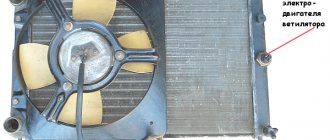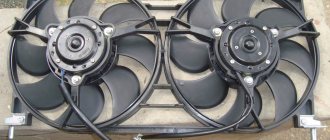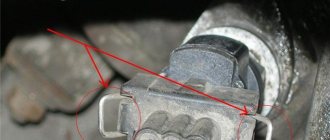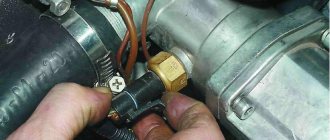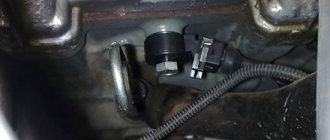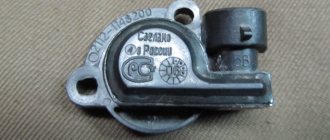To maintain optimal temperature conditions of the car engine, a cooling system is designed.
Its main elements are channels for antifreeze in the cylinder block, pipes, a thermostat, a radiator, and the electrical part includes a VAZ 2110 fan switch sensor, a temperature sensor and an electric motor with an impeller for cooling the radiator. Late detection of cooling system defects can lead to engine overheating and costly repairs.
Fan switch sensor LS 0108 (TM-108)
Connection schemes
In VAZ 2110 injection and carburetor engines, the TM-108 bimetallic temperature sensor is used in different ways to control turning the fan motor on and off.
For carburetor engines it is located on the radiator on the left in the direction of travel. When the threaded part located directly in the coolant is heated, the bimetallic plate bends and closes the contacts. The voltage from the battery is supplied through a fuse to one contact of the electric motor, the second, when the sensor is triggered, is connected to the housing, setting the impeller in motion.
Fan switching sensor (carburetor VAZ 2110)
For VAZ 2110 and TM-108 injectors, it is located near the thermostat, the signal is sent to the electronic control unit (ECU). The control signal from the ECU is sent to the cooling system fan relay, which, similar to the sensor of a carburetor engine, controls the electric motor.
Injection fan switch sensor
All engines have another device in the cylinder block, the signal of which is used to indicate the coolant temperature on the panel in the cabin.
Before independently repairing the fan switch sensor, it is recommended to understand in detail the design of the cooling system: https://vazweb.ru/desyatka/dvigatel/sistema-ohlazhdeniya-dvigatelya.html
The fan does not turn on
There may be several reasons for this:
- Fuse. In the mounting block, fuse F7, rated 20 amperes, may be faulty - it is responsible for powering the electric fan and sound signal circuits;
- Thermostat. The liquid circulates only in a small circle, the radiator and sensor do not heat up, and accordingly, the fan does not turn on. You can check by simply probing the pipes; those connecting to the radiator should begin to warm up after opening the thermostat;
- Sensor. For a VAZ 2110 with a carburetor, the contacts are closed for testing; if the device malfunctions, the electric fan will turn on. The connector of the injection motor must be disconnected; with the remaining elements working, the ECU will detect a break in the circuit and issue a constant alarm signal to the relay, which will forcibly turn on the electric motor for cooling;
- Cooling system fan relay for VAZ 2110 injection engines. The sensor is turned off and the power contacts on the relay located in the additional fuse box are closed. If everything works, then we check the control winding: on one contact there is always a positive from the main relay, connecting the second to the body, we try to hear the operation click. But it’s better to simply replace the relay for testing, temporarily, with a known good one;
- Electric motor. During testing, the connector is disconnected; to force the impeller to turn on, voltage is supplied directly from the battery.
If all the elements are working properly, then you need to look for a break in the wires, “ringing” them one by one. Poor contact of the relay and sensor connection wire terminals with the car body is also possible. The worst case scenario would be an ECU failure, in which case the signal from “leg” 46 usually “floats” and does not reach the values of +12 volts (off) and 0 (on).
An article devoted to independent modification of the thermostat and its replacement is here: https://vazweb.ru/desyatka/ohlazhdenie/dorabotka-termostata.html
The fan runs constantly
This is a rarer defect and occurs in the following cases:
- The sensor contacts do not open, the “Check Engine” lamp is on, for carburetor VAZ 2110, when the connector is disconnected, the fan turns off;
- The wires to the device are broken (only at the injector);
- The relay is stuck in the closed state.
To eliminate the malfunction, it is necessary to replace the failed element.
Checking at home
Sometimes the electric motor turns on too late, when the antifreeze temperature is already high. This may be caused by a malfunction of the valve in the radiator cap or abnormal parameters of the switch on sensor. You can check the device’s response temperature at home using a multimeter and thermometer.
After disconnecting the electrical connector, the sensor is unscrewed with a key. To avoid burns, remove the device only from a cold engine, after draining the antifreeze. When reinstalling, it is advisable to use a new sealing copper washer and not apply too much force when tightening.
The intricacies of replacing antifreeze are studied in detail in this article: https://vazweb.ru/desyatka/ohlazhdenie/zamena-antifriza.html
The switching temperature is engraved on the end; it can be from 92 to 95 degrees. To check, you need to connect the multimeter in resistance measurement mode and immerse the threaded part in a container of water.
While heating the water and monitoring the readings of the multimeter, we use a thermometer to record the moment it turns on, and when it cools down, the temperature it turns off. Standardly, these are 92 and 87 degrees; with significant deviations, late operation is especially critical, the device requires replacement.
To improve cooling, it is possible to install a double fan from Niva. There are two modifications for placement: after the radiator or in front of it.
Nivovsky injection radiator 21214-1300024-43 (placed in front of the radiator)
On the VAZ 2110, any of the options can be installed with minimal modifications to the fasteners on site. When electric motors are connected in parallel, the current consumption increases to 40 amperes, which requires replacement of the wiring.
Nivovsky suction radiator (placed after the radiator)
Monitor the engine temperature.
If you notice overheating too late, then in addition to boiling of the antifreeze and a forced stop, more serious consequences are possible: deformation of the cylinder head, jamming of the camshaft.
If there are defects in the operation of the cooling system fan of the VAZ 2110, the faults can be diagnosed independently by checking the thermostat, electric motor, relay, and switch sensor.
- ratico19
Where is
Drivers who have never encountered a malfunction in forced engine cooling before may not know where the internal combustion engine is located. On a carburetor VAZ 2110, this element of the cooling system is located on the radiator. If the driver finds this part, then he can easily find the fan switch sensor, which is located on the side. A characteristic feature of the product is the electrical wires connected to it. On the injection VAZ 2110, this part can be found on the cylinder block.
VAZ 2110 fan switch on sensor to guard the engine temperature
The standard fan switch-on sensor is designed to trigger the relay during a period when the temperature of the liquid intended to cool a running motor reaches certain values, above which the engine will overheat.
Often, novice car enthusiasts ask the question where the fan switch on for the VAZ 2110, and other passenger cars, is located. We inform you that such a device is located on the car radiator. This device cannot be repaired and replacing the fan switch sensor if it fails is the only solution.
On the “ten”, however, like on many other cars with liquid cooling of the power plant, an electrically driven climatic fan unit is used to stabilize the operating temperature of the engine. Putting the fan into operating mode, as well as taking it out of this position, takes place automatically, and the fan switch-on sensor serves as a signaling device in case of emergency exceeding of temperature values.
If the “ten” is equipped with a carburetor-type engine, then to perform the function of warning about overheating of the power plant, a TM-108 thermobimetallic type cooling fan switching sensor is used, while in VAZ 2110 injectors these functions are assigned to the controller.
If the fan installation is “commanded” by the fan switching sensor, then its initiation is directly related to the temperature setting of this device. This information can be obtained by reading the labels on the product body.
When the temperature reaches critical values, the fan switch sensor must initiate operation of the fan unit. If this does not happen, you should look not only where the fan switch sensor is located, but also the malfunction of this control device.
The test for the functionality of the device is quite simple - you just need to short-circuit the contacts of the device and, if the fan unit works when it starts, then you need to replace the fan switch sensor with a working element.
Fuse
The elementary rules of physics state that the water contained in the coolant boils at a temperature of 100 degrees.
If the fuse valve, which is located on the expansion tank, fails, and the pressure inside the tank increases, then the liquid will boil, but the fan will not start working. The cooling element will not turn on even if the electrical circuit is working properly. This all happens because the component switching sensor on the injection VAZ-2110 has a startup temperature of more than 100 degrees.
To solve the problem with the fuse, you will need to replace the cap of the expansion tank. The new part must correspond to the possible pressure inside the system and operate in a situation where the fluid temperature reaches 105 degrees. This will result in the fan blades turning on.
Replacing the VAZ fan sensor. How to do it?
Today we are changing the fan switch sensor!
As you know, overheating the engine leads to absolutely nothing good. To prevent this from happening, car manufacturers began to install radiator cooling fans, and often even more than one.
This article contains detailed instructions on how to replace the sensor for turning on an electric radiator cooling fan with your own hands.
You can also watch a video that clearly shows the essence of the process in detail.
- General theoretical information
- Where is the fan switch located?
- At what temperatures should it work?
- On what principle does it operate?
- Other reasons for a fan not working
- Checking the functionality of the fan switch sensor
- Replacing the fan switch sensor
- Tools
- Replacing the sensor
- Replacement without draining antifreeze
General theoretical information
Sectional view of the fan switch sensor
Where is the fan switch located?
So:
- The answer to this question is very simple - in the stove radiator. In different cars and on different radiator designs, the sensor may be located in the left or right tank, below or above, but it will always be located in the radiator.
- It is very easy to determine - this is the only thing in the radiator to which the electrical wiring wires fit, and there are few things in the radiator area that can be unscrewed with a 30 key . So when replacing the fan sensor on a VAZ 2107 or another VAZ, it is very difficult to make a mistake.
This is what the sensor looks like on a car
At what temperatures should it work?
- Sensors are available with different temperature limits.
- Often the fan sensor turns on at 92 degrees and turns off at 85-87 degrees.
- There are sensors with on-time intervals from 92 to 98 and off intervals from 82 to 87. When purchasing, choose the same sensor you had or the most common one - 92/87.
On what principle does it operate?
In order to replace the fan switch sensor on a VAZ 2110, this, of course, is not necessary to know, but it will be useful for general development:
- The sensor contains a contact group.
- When the coolant inside the radiator heats up, the sensor contacts heat up and expand.
- Reaching a certain limit, the contacts close, a signal is transmitted to the wires and the fan is activated.
If your electric cooling fan stops turning on, do not rush to blame the sensor. Before replacing the fan switch sensor on a VAZ 2106 or another model, check the remaining points. This:
- Fan malfunction. One of the reasons may be that the cooling fan itself is not working properly. The cost of replacing it, of course, is more expensive than the sensor, but anything can happen.
- The operation of the fan cannot always be checked by closing the two contacts of the fan sensor. Because the circuit may be broken.
- The most reliable way to check the operation of the fan is by connecting its contacts directly to the battery, using two long wires. If the fan does not work, it should be replaced.
Checking the functionality of the fan switch sensor
Replacing the VAZ 2114 fan switch sensor - checking the sensor
You can check the new sensor before replacing, or you can check the old one after replacing to ease your conscience. How to do it? It’s very simple - all you need is a multimeter, a thermometer, a container and water or coolant.
So:
- Pour water or coolant into the prepared container.
- Lower the threaded part of the cooling sensor there.
- Connect the terminals of the multimeter to the contacts of the sensor and put it in resistance measurement mode, and if there is a continuity mode, then it is better to use it.
- Dip the thermometer into the liquid.
- Next you need to heat the water.
- When the liquid temperature reaches the level at which the sensor should turn on (usually 92 degrees), its contacts should close and the multimeter should beep.
- If this does not happen, the sensor is faulty and should be replaced.
Advice. Don't be surprised if you purchased a faulty sensor. Just go to the seller and exchange it for a new one.
Replacing the fan switch sensor
This section covers replacing the fan switch on VAZ 2107, 2110 and 2114. Fundamentally, all these processes are the same on any car, the differences are only in the details.
Advice. Before replacing the sensor, read the instructions and look at the photo.
Tools
You don't need much for this operation:
- 30 ring wrench
- Rags
- Coolant container
As you can see, replacing the VAZ 2109 fan switch sensor yourself will not cost much. You only have to buy a sensor.
Replacing the sensor
Note! It is best to replace the sensor on a cold engine. This way you can avoid getting burns to the skin of your hands and other parts of the body.
Design
The cooling system includes many components. Among those that interest us today, which can cause problems with the radiator fan, we note:
- Electric fan. This unit starts working when the coolant temperature reaches 100-105 degrees Celsius;
- Fan switch sensor. It is configured to operate precisely within the specified temperature range. The sensor is located on the inlet pipe of the cylinder block (labeling from the sensor factory is LS0112);
- Fuse marked F7. It is located in the mounting block;
- Fan relay. You will find this unit already in the cabin, under the right panel of the front console.
If the radiator fan does not work on your VAZ 2110, the cause of the malfunction should be looked for in the above-mentioned system elements. Although there may be one situation in which the electrical circuit has nothing to do with the fault.
What is a fan switch sensor? Maintenance and replacement of DVV VAZ 2110 | VAZ REPAIR
The fan switch sensor ( DVS ) is part of the engine cooling system and performs almost the same function as the thermostat.
If the engine temperature rises to a certain level, the sensor sends a signal to the ECU, after which the fan turns on and increases cooling of the engine radiator.
The fan removes heat from the radiator by forcing a flow of air onto the radiator fins.
The main task of the fan switch sensor, as well as the thermostat, is to prevent the engine from overheating.
The DVV on the VAZ 2110 is located on the radiator housing; if it malfunctions, it cannot be repaired and requires immediate replacement.
The fan is switched on and off automatically; in this chain, the fan switch on sensor acts solely as a signaling device.
How to check the fan switch sensor on a VAZ 2110?
- After the coolant temperature rises to a critical level, the fan switch initiates operation of the fan unit; if this does not happen, then there is a malfunction in the cooling system.
- In order to find the reason, it is not at all necessary to go to a service station; it is enough to conduct a simple test that will allow you to understand what is going on.
- You need to close the contacts of the device and look at the reaction of the fan; if it works, you need to replace the fan switch sensor.
- It also wouldn’t hurt to check the serviceability of the fan fuse; if it doesn’t work, replacing the DVV will not give any result, and the money will be wasted.
- Check the condition of the wiring; perhaps the reason is not in the sensor, but in the power supply or a connection to ground.
How to check the fan switch sensor using a multimeter?
To check, you will need water, an empty container, a thermometer and a heat source (gas or electric stove). Checking the fan switch sensor is no different from checking the thermostat.
- The principle is as follows: you need to pour water into the container.
- Lower the threaded part of the DVV there.
- Connect the multimeter terminals to the sensor contacts and turn the device into resistance measurement mode, or into “continuity” mode.
- Now gradually heat the water.
- After the water temperature reaches ~92°, the contacts of the working fan switch sensor should close, after which the multimeter should make a sound.
If you are convinced that the sensor is faulty, replace the sensor.
Do-it-yourself replacement of the VAZ 2110 fan switch sensor
- Remove the “-” terminal of the battery.
- Next, drain the coolant from the radiator and turn off the power from the fan switch sensor.
- Then you need to unscrew the DVV from the radiator housing, and install a new fan switch sensor in its place.
Diagnostics of VDV
If, as a result of replacing the sensor, the functionality of the cooling system is not restored, then the new part may be defective.
To make sure that the DVV is working, you need to perform the following simple steps:
- Remove the sensor from the car.
- Place it in a metal container with water.
- Place the tank on the gas stove.
- Boil.
- Remove the DVV from the container and measure the resistance between the contacts.
You can use an inexpensive multimeter or tester to perform the diagnostic operation. If, as a result of measurements, the presence of insignificant electrical resistance is established, then the sensor is in working order and can be used for its intended purpose. How to check this part is now clear, so if you don’t find an inexpensive used part, you can also install it after a diagnostic operation.
Checking and replacing the fan switch sensor on a VAZ 2110
Welcome, friends, to the DIY car repair website. It's no secret that engine overheating rarely ends in something good. Such a malfunction is fraught with a whole range of problems, which most often lead to the need for repairs and additional costs.
Fan switch on VAZ 2110
In such a situation, you can only rely on the cooling system, one of the main elements of which is the VAZ 2110 fan switch sensor (abbreviated as DVV).
Purpose of the fan switch sensor
As we have already mentioned, the DVV is part of the engine cooling system and duplicates the function of the thermostat. The main task of the sensor is to protect the vehicle’s power unit from overheating and promptly give a command to the ECU to turn on the fan. How does he work?
While the engine is running, the coolant temperature may rise. As soon as it reaches a certain level, the DVV gives a command to the electronic unit of the car.
The fan immediately starts and powerful air flows over the radiator. As a result, the coolant temperature decreases to the optimal level much faster.
Fan sensor location
Finding the sensor is not difficult - it is located directly in the radiator. A more precise location may vary (it all depends on the design features of the model of a particular year of manufacture).
For example, the DVV can be located in the right or left tank, in the lower or upper part of the radiator.
Finding the location of the sensor is not difficult. This is almost the only unit on the radiator from which wires extend. Another distinctive feature is the large nut head, which can be unscrewed with a “30” wrench.
Operating principle and triggering requirements
So, the main element of the DVV is the contact group inside the node. When the desired temperature is reached, the sensor contacts begin to expand and at a certain moment close. After this, the signal goes to the ECU, which, in turn, gives a command to the fan.
What should the switch-on temperature be? You must remember that DVVs are available with different temperature limits.
Most often, switching on occurs when 92 degrees Celsius is reached, and switching off occurs at 87. Sensors are also sold with other temperature ratings, but for the VAZ-2110 the 92/87 option is most suitable - so give preference to it.
Design and principle of operation
The VAZ 2110 fan sensor, both 8 and 16 valves, consists of a sealed housing, inside of which there is a bimetallic plate and electrical contacts. A feature of the working element is the possibility of significant physical expansion when heated. When the temperature changes significantly upward, the plate expands and the thermal relay contacts close.
On the outside of the housing, a thread is cut, which is necessary for reliable fixation of the sensor in the cooling system of the internal combustion engine. On the opposite side of the sensor, terminals are installed that are necessary for connecting the contact wires.
What to do if the cooling fan on the VAZ-2110 does not turn on
The VAZ-2110 is often called the “ten” among drivers.
Among such vehicles, one of the main problems is the breakdown of the heating and cooling system. The problem is unpleasant and causes considerable trouble for its owner, but it is quite easy to deal with it even with your own hands, without contacting a service center, and you will save a considerable amount. This article will tell you what to do if the cooling fan on the VAZ-2110 does not turn on. On average, a new purchased cooling fan for a VAZ-2110 ranges from 1 to 2.5 thousand Russian rubles. However, replacing its individual faulty parts will cost much less.
Symptoms of a problem
If the engine boils, and the characteristic hum of the cooling system fan is not heard, then with a high degree of probability one can suspect the presence of a malfunction of the internal combustion engine. The opposite situation, when forced cooling operates as long as the ignition is on, will also indicate a problem with the automation. On a VAZ 2110 injector, a constantly switched on fan sensor may indicate problems with the controller. The control unit could “remember” an error that appeared earlier and, as a result, the electric motor is activated every time it is started.
Periodic turning on and off of the fan when the engine is not yet warmed up is also a sure sign of an imminent failure of the combustion engine.
Safety valve
Knowing physics, you will agree that at normal atmospheric pressure, the water that is part of antifreeze boils at a temperature of 100 degrees Celsius.
To fix this problem, replace the expansion tank cap. The new element must maintain the pressure inside the system above atmospheric pressure, which will allow the laws of physics to work, the boiling temperature to rise to 105 degrees Celsius and thereby turn on the blades of the unit.
Procedure. Step-by-step instruction
If after completing the next step the problem goes away, further checks are stopped.
- Open the hood.
- Wait for the engine to cool down.
- Perform an initial visual inspection: integrity of the hoses, reliability of the clamps, absence of leaks or cracks.
- Make sure that the expander cover elements are in good condition. Remove scale, rust, clear holes, wipe, assemble. The absence of noticeable damage to parts gives hope that the product will work.
The valve design is elementary. The cover contains a spring. Functionally, it is designed to regulate the pressure in the cooling circuit. A hot engine increases it, a cold engine decreases it.
Compressing at a value of 1.1 atmospheres, the spring relieves excess pressure and prevents the destruction of hoses and the tank. As the motor cools, it creates a vacuum effect. The tank will begin to flatten. The valve equalizes the pressure.
The lid screws tightly on the thread, eliminating distortions. There should be a gap between it and the body. An overtightened valve will not work. It is difficult to test the device's operation in road conditions. You can check by replacing it with a known good one.
Inspect the electrical wiring elements to ensure a reliable connection
Possible factors for damage to electrical circuits:
- vibration;
- oxidation;
- burning;
- breakage, fraying of electrical wires;
- insulation aging, short circuit.
Switch the tester to resistance measurement mode. Remove it with special tweezers and ring the fuse link F7 located in the mounting block.
Replace the burnt-out element with a serviceable one with a rating of 20A. Inspect and clean the nest. Insert fuse.
It was not possible to find out the reason, the protection triggered again - look for a short circuit.
Disconnect the fan plug. Use a tester to measure the circuit of the electric motor windings. Zero resistance or a break indicate the need to replace the radiator blower electric drive.
Interturn short circuits that cause multiple replacements of fuse links cannot be measured with the device.
Sensor check
Start the car. Pull out the coolant temperature sensor connector. The fan starts working - the sensor needs to be replaced. Secure the disconnected wire. Drive to a nearby service station.
Relay test
There is a hatch on the floor at the front passenger's feet.
Below it is a built-in panel with three relays of the same type:
- fan installation;
- fuel pump;
- ignition (main thing).
By replacing each other, try to start the airflow. The VAZ 2110 fan does not work - go to the next step.
Where is the VAZ 2110 cooling fan relay located?
If you are wondering where the fan relay is located on a VAZ 2110, then this photo below will answer your question and you can easily find where the cooling fan relay is located on a VAZ 2110.
Check the electric motor
Winding measurements did not reveal a malfunction. Apply voltage briefly from the battery using additional insulated conductors. The operation of the fan indicates a malfunction of the controller, which does not output a signal to the relay.
- The only correct solution is to turn on the airflow directly and urgently visit a service station.
- Prevention of breakdowns of the cooling system of the VAZ 2110 injector 16 valves.
- Periodically inspect the components of the cooling system.
- Monitor the cooling temperature on the device, listen to the operation of the fan.
- Maintain coolant level. Replace after 2 years or 30,000 km.
- Use the solution to remove rust and scale.
- Signs of a change in the properties of the coolant are a change in color, an increase in fluidity.
- Check the density with a hydrometer.
- Do not mix coolants.
- Every twelve months, rinse the expansion tank cap with water and check it on a stand with a pressure gauge.
- Avoid contact of aggressive liquids with electrical wiring and electric motor windings.
Improvements to the fan start control circuit for the VAZ 2110 injector
The smooth functioning of the engine worries factory designers, auto mechanics, and car enthusiasts. Folk craftsmen change the design of valves and electrical circuits.
Installation of three position toggle switch:
- continuously on: the VAZ 2110 cooling fan does not work;
- constantly switched off: warming up the engine when starting in the cold season, automatic control is faulty;
- automatic mode: controlled by the controller, the equipment is working properly, the algorithm is executed correctly.
When choosing an installation location, consider the following conditions:
- prevent accidental switching;
- not to be confused with other controls.
It is important to remember when modifying the design about the safety of the changes made.

